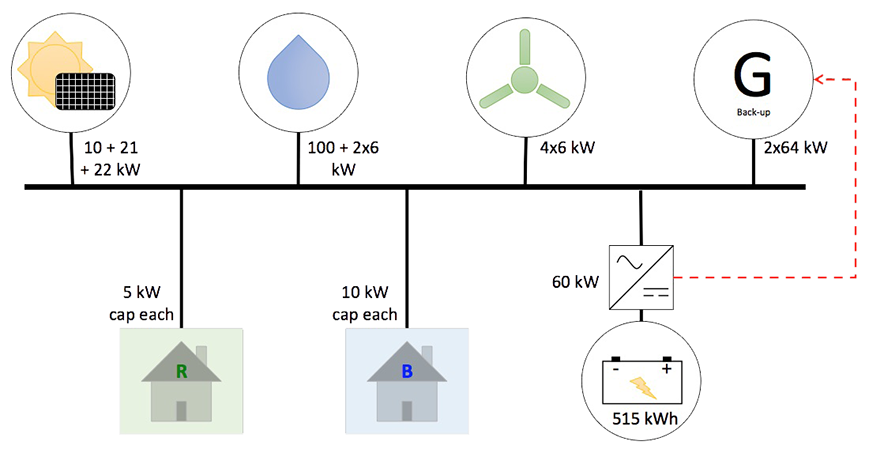Current Microgrid Configuration
Eigg relies on three different types of renewable power sources, back-up diesel generation and a battery bank. Each has a nominal rated power that characterises its power output.
Eigg Electric has a directive to keep the island as autonomous as possible. With this in sight, islanders are trained to perform maintenance on all the renewable sources to date. Only when more complicated repairs are necessary the supplier of the system comes to the island and shares the solution with the local technicians.
The table and image below illustrate these sources and their rated powers. Details of each follows, and datasheets corresponding to each of the current pieces of equipment can be found on the Useful Links page.

Eigg’s power systems quick reference table.
Eigg’s current electrical configuration diagram.
On Eigg’s current electrical diagram all energy production methods are shown along with generic representations of consumers (residential and business/community). Although there are other inverters in the system, the one represented above the battery bank is of note for two reasons: it limits the power flow to/from the batteries at 60 kW and it is responsible for the command signal (represented in a dashed red line) to the diesel generators. Each of the generation and storage system present will be discussed individually.
Photovoltaic Panels
Photovoltaic panels generate electrical energy by absorbing the radiation emitted by the sun. Three PV arrays were installed throughout the years, each having 10, 21 and 22 kW of rated power respectively. They are as described below:
- The 10 kW array consists of 60 x BP Solar BP3165S PV modules wired in series of six strings of 10 modules which are connected to one SMA Sunny boy SB-3000 each.
- The first expansion of 21 kW consisted of 126 x BP SOLAR BP4180 180W PV modules connected to 3 x SMC-7000HV inverters.
- The latest expansion of 22 kW included 90 REC Solar REC 250PE 250W PV modules connected also to 3 x SMC-7000HV inverters.
The inverters serve to convert from the DC power generated by the panels to AC power consumed by the network.
As seen in the graph opposite, PV panels are most effective in the summer months, and so not ideal for renewable heat in winter.

Generation by Eigg's PV arrays over the year 2014. This graph was created using real data from Wind & Sun.
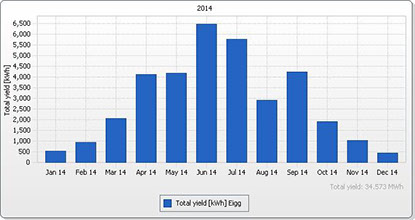
Hydroelectric
The Isle of Eigg has three hydroelectric systems: one large 100kW and two small 6kW rated power generators.
This system uses the potential energy on a water column to drive an electric generator.
The “large hydro” on Eigg is a run of river impulse Gilkes generator with a water column (head) of 124m high and a pipe length of 800m acting on an impulse turbine. This hydro scheme allows for flow through it even if no energy is required. This bypass was implemented to ensure there was no environmental impact from blocking the river, and the system is designed to maintain a minimum flow.
The energy produced by this hydro scheme is limited by the network frequency, therefore power is only produced by it when there is demand for it. Additionally, it depends on the rain that is more abundant on the winter, resulting in a greater energy generation on said season.
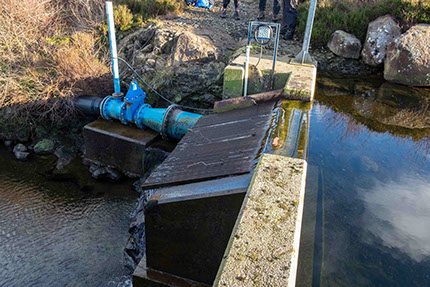
Left:
Large run of river hydro
Below:
internal parts and external view of small 6kW hydro.
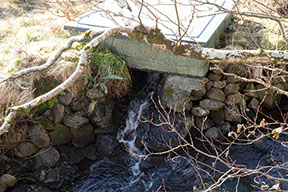
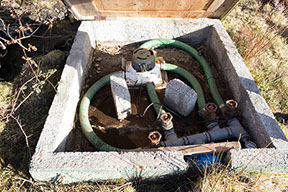
wind power
As noted previously, Eigg has huge wind resource. This is utilised by four wind turbines incorporated into the microgrid. Essentially, a wind turbine converts kinetic energy to electrical energy, by using blades to rotate a shaft and thus power a generator. These are four Proven 6kW turbines, each 15m high, totalling in a 24kW rated power output. These are installed at the southern part of the island, a location with optimal wind exposure.
Onshore wind speeds vary and so the generated power is also stochastic and unpredictable. Therefore, reliability on wind is low to avoid power loss when there are days without wind. There is no major variation in wind generation between summer and winter months - only a slight increase in winter is observed.
The wind farm also produces large amounts of excess energy, which may be considered as a by-product. The electric network must consume or store the energy it produces in the same instant it is produced. Otherwise there may be potentially damaging frequency or voltage oscillations.
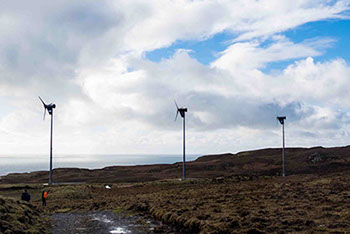
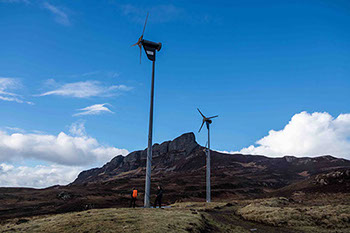
Eigg’s current wind instalments
diesel generators
The island has two 64kW back-up diesel generators that are used to supply additional power in case renewable generation under-performs. In reality, the second generator is used as a back-up for the first for added security.
When the battery bank charge state falls bellow 50% and demand remains greater than production, the inverters send a signal to the stand-by diesel generator to run. When the charge state gets above 90% then the diesel generators are turned off.
Therefore the renewable penetration (the percentage of renewable electricity being used as measure of total electricity) correlates to how much energy the diesel generator has contributed to the island’s grid. It is desirable that the generators run as infrequently as possible in order to optimize the usage of renewables and avoid releasing additional CO2 to the environment.
Currently the island has a near 90% yearly renewable penetration. Meaning that the diesel generators are usually responsible for only 10% of the power on the island’s electrical grid.
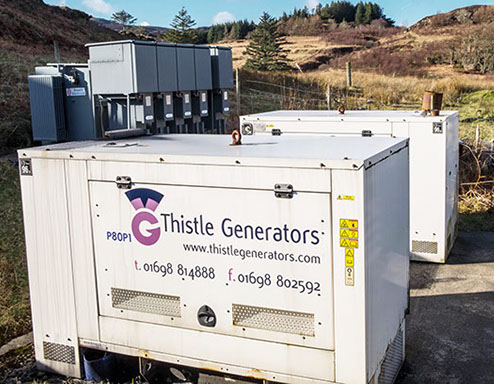
Eigg's two diesel back-up generators, currently supplying approximately 10% of the yearly supply.
Monthly Power Production
With all energy sources defined, simulation using HOMER software produced the graph below showing how much of each source type generates every month.

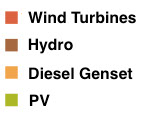
battery bank & inverters
Due to the stochastic nature of the renewable resources on which Eigg relies, the island depends on a battery bank for security of supply. When the power being produced is greater than that demanded by the island, it is measured though an increase in frequency and this excess is diverted to the battery bank, charging the batteries. If the demand is greater than the production and the battery charge is above 50% then the bank will provide energy to the grid. This 50% limitation was imposed because not using the whole charge capacity of the batteries can extend their life span, therefore avoiding early replacement costs.
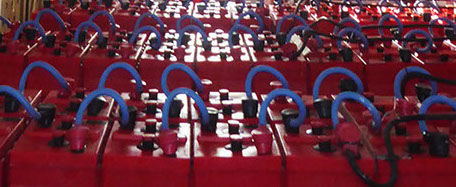
The battery bank and inverter system consists of 96 x Rolls Solar RB 4KS25PS batteries arranged into four clusters of 24 batteries each. Additionally, the battery bank connects to the main grid through 12 x Sunny Island SI-5048 5kW inverters.
The twelve inverters converts from the DC power of the batteries to the AC power of the grid and vice-versa. The current inverter configuration only allows from a flow of 60kW from and to the batteries at any moment. This limitation is cumbersome since peak supply or demand will possibly not be dealt with adequately.
Eigg's battery bank
Demand side management
The end users have a meter that is used with a pre-paid card to pay for their electricity. As a way to keep the energy demand in check, fuse breakers were installed in every building. These limit, with a slow fuse, the instantaneous power consumption to 5kW for residential dwellings and 10kW for commercial buildings.
When power generation is too great and the batteries are fully charged then the frequency starts to rise. There are some measures to prevent this. The first line of defence comes in the form of frequency controlled switches that power heaters throughout community building when this excess energy is detected. The second line is on the wind turbines that divert power to outdoor heaters simply to keep the network stable.
© University of Strathclyde | TEC Eigg | Sustainable Engineering 2016
